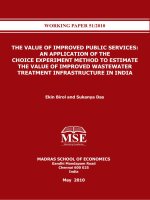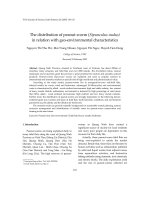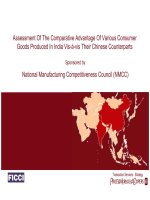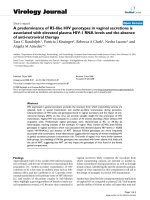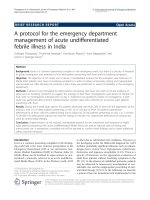Optimization of technical process for manufacture of peanut powder enriched Burfi
Bạn đang xem bản rút gọn của tài liệu. Xem và tải ngay bản đầy đủ của tài liệu tại đây (1.46 MB, 8 trang )
Int.J.Curr.Microbiol.App.Sci (2018) 7(9): 1344-1351
International Journal of Current Microbiology and Applied Sciences
ISSN: 2319-7706 Volume 7 Number 09 (2018)
Journal homepage:
Original Research Article
/>
Optimization of Technical Process for Manufacture of
Peanut Powder Enriched Burfi
Preeti Yadav, D.C. Rai, Uday Pratap Singh* and Vikas Patel
Department of Animal Husbandry and Dairying, Institute of Agricultural Sciences, Banaras
Hindu University, Varanasi-221005, UP, India
*Corresponding author
ABSTRACT
Keywords
Central composite
rotatable design, Burfi,
Sugar, Peanut, Response
surface methodology
Article Info
Accepted:
10 August 2018
Available Online:
10 September 2018
In India, burfi is most popular khoa based milk sweet, white to light cream in colour with
firm body and smooth to granular texture. Sugar is added in different proportion and other
ingredient incorporated according to demand by consumer. Milk burfi is an Indian
traditional confectionery prepared using concentrated milk and sugar. Peanut are rich in
protein, oil and filaments. Levels of ingredients in burfi such as peanut powder, sugar and
khoa were optimized using response surface methodology (RSM) for its physico-chemical
properties basis. The best formulation was experiment no. 6 with 10 % peanut powder, 20
% sugar and 80%. This formulation was found to be most appropriate for manufacture of
peanut powder enriched burfi with predicted scores of, 12.255%, 62.29%, 33.09, 23.34 and
2.45% for get maximum possible quality moisture, fat, carbohydrate, protein, and ash
respectively. Due to presence of Peanut nutritional value of burfi is increased as compare
to other burfi available in market it is cheap and nutritious too.
Introduction
In India, burfi is most popular khoa based
milk sweet, white to light cream in colour with
firm body and smooth to granular texture.
Sugar is added in different proportion and
other ingredient incorporated according to
demand by consumer. Various forms are made
with varying types of additives depending
upon regional preferences. Several varieties of
burfi are sold in market depending on the
additives present viz., plain, mava, pista, nut,
chocolate, coconut and rava burfi. A large
variation can be observed in physical
attributes of market samples. Good quality
burfi however, is characterized by moderately
sweet taste, soft, and greasy body and smooth
texture with very fine grains. Colour, unless it
is chocolate burfi, would be white or
yellowish. burfi retains its quality for
considerable long period at atmospheric
temperature due to its low moisture content
and higher concentration of sugar. The method
of preparation also ensures the destruction of
almost all microorganisms present in raw
material. During preparation, handling,
packaging and storage, contamination from
undesirable micro-organisms is avoided.About
50–55% of milk produced is converted into a
variety of Indian milk products by the
traditional sector (by halwais or sweetmeat
makers) using processes such as heat
1344
Int.J.Curr.Microbiol.App.Sci (2018) 7(9): 1344-1351
desiccation, heat acid coagulation and
fermentation, out of which about, 5.5% of
total milk production is utilized for khoa
making
in
India
(Banerjee
1997;
Bandyopadhyay et al., 2006). But according to
Nygaard (1996) about 7% of total milk
produced in India is converted into khoa.
Khoa (mawa, khoya, khawa) is a heat
desiccated milk product used as a base
material for a large variety of sweetmeats like
burfi, peda, gulabjamun, etc. Cow milk
usually yields 17–19% of khoa by weight. The
yield of khoa from buffalo milk is reported to
be 21–23% by weight (De 1980). The shelf
life of khoa is short which limits its marketing
(Ghatak et al., 2003 and Zia-ur Rehman and
Salariya 2006). Khoa is the major constituent
as raw material for the preparation of burfi,
Peda, Gulabjamun, Doda burfi, Malai role and
certain other sweets. Traditional dairy
products have great commercial significance
as they account for over 90% of all dairy
products consumed in the country (Aneja et
al., 2002). burfi is also called as Indian
cheesecake, as the dessert exudes a hint of
cheese and also resembles different kinds of
hard cheeses, even though these sweets taste
entirely different from any cheese recipes.
Some of the most common varieties of burfi
includes Doda burfi (Jha 2003), Kaju- burfi
(Rao et al., 1993), Groundnut burfi (Khan et
al., 2006), mango burfi (Shelke et al., 2008),
coconut burfi (Gupta et al., 2010), bitter gourd
burfi (Srivastava and Saxena 2012), and burfi
with honey (Kadam 2010). Other varieties of
burfi are also available like besan burfi, pista
burfi, kesar burfi, rava burfi, chocolate burfi,
jackfruit burfi, rice flakes burfi, tricolor burfi,
apple burfi and so on. Good quality burfi,
however, is characterized by moderately sweet
taste, soft and slightly greasy body and smooth
texture with very fine grains. High-intensity
low-fat and protein enriched burfi provide
consumers with many benefits, both
psychologic
and
physiologic.
Health
professionals and consumers believe that low-
fat and protein enriched food product are
effective in weight maintenance, weight
reduction, reduction of dental cavities and
reduction in the risks associated with obesity.
Peanuts are believed to have originated in
Central American region from where they
spread to other parts of the world. They are
widely cultivated in India, Africa, South
America, United States (D D Tom 2007),
China (G. Yao 2004) and a few other
countries. Peanuts often are enriched with
health benefiting nutrients that are beneficial
to human health. They are actually legumes
but are the most frequently eaten “nut” in the
United States. Studies show that peanuts,
peanut butter, and peanut oil significantly
reduce the risk of heart disease when
consumed daily, similar to other nuts. More
than 300 different varieties of peanuts are
grown worldwide, which include Virginia,
Valencia, Georgia runner, Tennessee red,
Tennessee white and many others. They are
usually consumed after roasting or boiling,
and also processed into different forms such as
peanut butter, candy, chocolates, cakes, and
others. Peanut butter and jelly sandwiches are
popular in the American culture (W H F
2007), with raw, roasted, shelled or unshelled
forms of peanuts being available in United
States throughout the year. Peanuts vary in
color from red to brown and are usually coarse
in their appearance. Raw peanuts and peanuts
prepared without salt are naturally low in
sodium, having 18 mg of sodium per 100 g.
This equates to only 5.4 mg of salt in a 30 g
serving. The nutritional importance of peanuts
is due to the energy and growth supplementing
constituents present in them. These include
carbohydrates, lipids, proteins, vitamins,
minerals, some organic acids and purines. It is
estimated that as much as 30% of the
population from many countries in the world
are suffering from malnutrition (FAO 2000).
Peanuts, which are a rich source of protein and
essential amino acids, can help in preventing
malnutrition (G H Pelto and M Armar-
1345
Int.J.Curr.Microbiol.App.Sci (2018) 7(9): 1344-1351
Klemesu, 2011). Moreover, peanuts contain
lipids and carbohydrates which are energy rich
compounds, capable of complementing the
basic energy demands of the human body. In
this article the chemical composition of
peanuts, all types, dry-roasted, without salt is
reviewed, and their importance as a useful
source of nutrition is discussed. The present
experiment was undertaken to optimize
production of peanut powder-based Indian
dairy dessert (burfi) using a statistical software
tool namely response surface methodology
(RSM) to optimize the various parameters in
the production of food products with desired
quality four. The numerical process
optimization was carried out by Design Expert
9.0.5 by applying response surface
methodology, many solutions were obtained
for the optimum covering criteria with a
highest desirability of 1.0 under these
circumstances, the solution contained the
maximum peanut powder, sugar and khoa
were in the normal range. The solution was
obtained for optimized peanut enriched burfi
condition by incorporation of 10 % peanut,
20% sugar and 80% khoa. Several workers
have used response surface methodology
(RSM) for optimization studies of cake
formulations (Macdonald and Bly 1966).
by the Central composite rotatable design
(CCRD) of Design expert, which were
conducted to obtain a combination of selected
parameters for production of the best quality
peanut enriched burfi.
Preparation of
enriched burfi
peanut
powder
based
Burfi was prepared by following the
traditional method of preparation (Ramna et
al., 1983).
Results and Discussion
Effect on moisture
The Moisture score varied from 12.50 to 12.33
(Table 2). The minimum moisture was
obtained for experiment no.11 while
maximum was obtained in experiment no. 1.
Figure 1 shows that response surface plot for
Moistureas influenced by the level of sugar
and peanut, by keeping khoa constant. From
the figure 1 and it can observed that there was
significant effect on Moisturewith the increase
in the level of sugar. These finding are
agreement with Sachadeva and Rajorhia
(1982) found the moisture content in burfi
12.71 to18.96 per cent.
Materials and Methods
Effect on Fat
The experimental work was performed in the
research laboratory of Animal Husbandry and
Dairying, Institute of Agricultural Sciences,
Banaras Hindu University, Varanasi. A
laboratory
experiment
conducted
for
manufacturing of peanut blended with khoa,
and sugar as main ingredients was optimized.
Peanut and sugar were procured from local
market. Buffalo milk was procured from dairy
farm of Banaras Hindu University. Various
levels of peanut (10-20%) sugar (30-40%) &
khoa (60-80 %) (Table 1) and three different
temperatures (85°C, 87°C and 90°C) were
used in the investigation. 20 trials generated
The Fat varied from 24.38 to 30.03 (Table 2).
The minimum fat was obtained for experiment
no.20 while maximum was obtained in
experiment no.6. Figure 2 shows the response
surface plot for fat as influenced by increase in
the level of khoa, sugar and peanut. From the
figure, it can be observed that with the
increase in the level of khoa, sugar and peanut
the fat was affected by optimum level of khoa,
sugar and peanut. This investigation is agreed
with results obtained by Verma and De (1978)
as 16.83 to 18.73, Wankhede (2005) in mango
burfi.
1346
Int.J.Curr.Microbiol.App.Sci (2018) 7(9): 1344-1351
Table.1 Independent variables used for optimization
Independent
Variables
Symbol Code
Unit
Peanut powder
Sugar
Khoa
A
B
C
%
%
%
Actual levels
Low
High
10
20
30
40
60
80
Table.2 Experimental runs and Actual values of factors used in central
composite rotatable design
Runs
1
2
3
4
5
6
7
8
9
10
11
12
13
14
15
16
17
18
19
20
Khoa
70
60
70
80
60
80
80
60
70
80
70
87
70
60
70
70
70
70
53
70
Variables
Sugar
Peanut
35
15
30
20
35
15
40
10
40
10
30
10
40
20
40
20
35
15
30
20
35
15
35
15
35
15
30
10
35
23
27
15
35
15
43
15
35
15
35
7
Moisture (%)
12.33
10.38
11.17
10.35
11.23
12.25
10.30
11.74
11.83
11.40
12.50
11.80
10.37
10.47
11.81
10.54
11.77
11.50
10.53
10.15
Physico-chemical properties
Fat (%)
Carbohydrate (%)
Protein (%)
48.58
33.29
24.66
52.93
28.04
20.77
50.81
30.16
22.34
53.86
27.96
20.71
56.95
30.32
22.46
62.29
33.09
23.34
58.72
27.81
20.60
59.18
31.71
23.49
60.39
31.94
23.66
58.36
30.78
22.80
49.03
33.00
22.03
50.32
31.86
23.60
54.89
28.00
20.74
58.13
28.27
20.94
52.35
31.90
23.63
61.30
28.47
21.09
59.25
31.78
23.54
61.60
31.05
23.00
58.27
28.43
21.06
49.42
27.42
20.31
Fig. 1
Fig. 2
Surface Plot of Moisture vs peanut, khoa
Surface Plot of Fat vs peanut, khoa
Hold Values
sugar 35
Hold Values
sugar 35
28
18
Fat
M oisture 17
16
15
50
60
70
k hoa
25
20
20
15
26
24
25
22
peanut
15
50
10
60
70
k hoa
8
80
1347
10
80
peanut
Ash (%)
2.47
2.08
2.23
2.07
2.25
2.45
2.06
2.35
2.37
2.28
2.50
2.36
2.07
2.09
2.36
2.11
2.35
2.30
2.11
2.03
Int.J.Curr.Microbiol.App.Sci (2018) 7(9): 1344-1351
Fig. 3
Fig. 4
Surface Plot of Protein vs peanut, khoa
Surface Plot of Carbohydrate vs peanut, khoa
Hold Values
sugar 35
Hold Values
sugar 35
3 2 .5
Carbohydrate
24
3 0 .0
Protein
27.5
25
15
5
50
60
70
k hoa
25
20
20
25.0
22
20
15
peanut
50
10
60
80
70
k hoa
peanut
10
8
80
Fig. 5
Surface Plot of Ash vs peanut, khoa
Hold Values
sugar 35
2 .4
Ash
2.2
25
2.0
20
15
50
60
70
k hoa
peanut
10
8
80
Flow-chart for preparation of peanut enriched burfi
Receiving of buffalo milk
↓
Pre-heating (35-40oC)
↓
Filtration Standardization of milk (6 per cent fat and 9 per cent SNF)
↓
Boiling of milk with continuous stirring-cum-scrapping Pasty consistency of khoa
↓
Lowering of temperature upto 88-89 oC
↓
Addition of peanut and sugar (25 per cent by weight at khoa) as per treatment
↓
Continuous stirring with wooden khunti on low flame up to solid mass stage
↓
Spreading in tray and cooling
↓
Setting
↓
Cutting in to rectangular blocks
↓
Packaging in butter paper
↓
Storage at room temperature
1348
Int.J.Curr.Microbiol.App.Sci (2018) 7(9): 1344-1351
Effect on carbohydrate
The Carbohydrate varied from 49.42 to 62.29
(Table 2). The minimum carbohydrate was
obtained for experiment no. 20 while
maximum was obtained in experiment no. 1.
Figure 3 shows the response surface plot for
carbohydrate as influenced by increase in the
level of khoa and peanut.
From the figure, it can be observed that with
the increase in the level of khoa, sugar and
peanut the carbohydrate was affected by
optimum level of khoa and peanut. Kathalkar
(1995) reported the carbohydrate content of
milk ber pulp burfi ranged between 51.52 to
63.14 per cent.
Effect of protein
The protein varied from 20.31 to 24.66 (Table
2). The minimum protein was obtained for
experiment no.20 while maximum was
obtained in experiment no. 1. Figure 4 shows
the response surface plot for protein as
influenced by increase in the level of khoa,
sugar and peanut. From the figure, it can be
observed that with the increase in the level of
khoa, sugar and peanut the protein was
affected by optimum level of khoa, sugar and
peanut. Bankar (2011) prepared pineapple
burfi and found that protein content of the
product ranged between 13.29 to 15.21 per
cent.
Effect on ash
The Ash varied from 2.03 to 2.50 (Table 2).
The minimum ash was obtained for
experiment no. 20 while maximum was
obtained in experiment no. 11. Figure 5 shows
the response surface plot for ash as influenced
by increase in the level of khoa, sugar and
peanut. From the figure, it can be observed
that with the increase in the level of khoa,
sugar and peanut the ash was affected by
optimum level of khoa, sugar and peanut.
Wakchaure (2003) recorded the ash content of
sapota pulp burfi as 2.11 to 2.41 per cent.
Due to presence of Peanut nutritional value of
burfi is increased. Hence, the formulation
with 10% peanut powder, 20% sugar and 80%
khoa, experiment no.6 was considered to be
the most appropriate for manufacturing of
peanut enriched burfi with the predicted
scores of 12.25%, 62.29%, 33.09, 23.34 and
2.45%
to
get
maximum
possible
qualityparameter
i.e.
Moisture,
fat,
carbohydrate, protein, andash respectively.
From these results, it could be concluded that
peanut powder enriched burfi can be
manufactured by the dairy industry to
promote value addition, export promotion and
product diversification.
References
Aneja, R.P., Mathur, B.N., Chandan, R.C. and
Banerjee, A.K. (2002) Technology of
Indian Milk Products, New Delhi: Dairy
India Publication, pp 122–125 and 150–
155.
Bandyopadhyay, M., Mukherjee, R.S.,
Chakraborty, R. and Raychaudhuri, U.
(2006) A survey on formulations and
process techniques of some special
Indian traditional sweets and herbal
sweets, Indian Dairyman, 58, 23–35.
Banerjee, A.K. (1997) Processes for
commercial production, Dairy India 5th
edn. Published by PR Gupta, New
Delhi, India, pp. 387.
Bankar, S.N. (2011). Preparation of pineapple
burfi.M.Sc. (Agri.) Thesis, submitted to
M.K.V., Parbhani (MS).
De, S. (1980) Outlines of dairy technology,
Oxford University Press, New Delhi.
FAO, “The spectrum of Malnutrition,” 2000.
/>nglish/fsheets/mal nutrition.pdf
1349
Int.J.Curr.Microbiol.App.Sci (2018) 7(9): 1344-1351
Ghatak, P.K., Sarkar, K., Moulick, S. and
Ray, P.R. (2003) Enhancement of Shelf
Life of Kalakand with Food Additives,
The Indian Journal of Nutrition and
Dietetics, 40, 212-217.
Gupta, V., Vijayalakshmi, N.S., Ashwini, B.,
Anbarasu, K., Vijayalakshmi, G.,
Prakash,
M.,
Indiramma,
A.R.,
Rangarao, G.C.P. and Ramesh, B.S.
(2010) Shelf life enhancement of
coconut burfi –an Indian traditional
sweet, Journal of Food Quality, 33,
329–349.
DOI:
10.1111/j.17454557.2010.00312.x
Jha, A. (2003) Development and evaluation of
malted barley flour supplemented Doda
burfi. M.Sc. Thesis, Bundelkhand
University, Madhya Pradesh, Jhansi,
India.
Kadam, V.S., Kadam, R.M., Choudhari, D.M.
and Pawar, B.K. (2010) Assessment of
organoleptic characteristics and cost of
Production of burfi prepared by using
honey as natural sweetener, Journal of
Dairying, Foods and Home Sciences, 29
(3/4):180-184.
Kathalkar, V.S. (1995). Studies on
preparation of milk ber pulp burfi.
M.Sc. (Agri.) Thesis, submitted to
M.K.V., Parbhani (MS).
Khan, A.Q. (2006). Milk and milk products
an entrepreneurial approach, All India
dairy business directory, pp.115-117.
Macdonald
TA,
Bly
DA
(1966)
Determination of optimum levels of
several emulsifiers in cake mix
shortenings. Cereal Chem 43:571–584
Nygaard, H. (1996), India’s Dairy Sector is
expanding, Maclkeritidende, 109, 5253.
Pelto, G. H., and M. Armar-Klemesu, (2011)
“Balancing Nurturance, Cost and Time:
Complementary Feeding in Accra,
Ghana,” Maternal & Child Nutrition,
Vol. 7, No. 3, pp. 66-81
Ramanna, B.R., Bhat, K.K., Mahadevaiah, B.,
Dwarkanath, C.T., Dhanaraj, S.,
Pottery, V.H. and Sen, D.P. (1983).
Investigation on large scale preparation
and preservation of milk burfi. J. Food.
Sci. Technol., 20:67-71.
Rao, T.S.S., Reddy, T.H. and Jayaraman, K.S.
(1993) Studies on development of
cashewnut burfi, Journal of Food
Science and Technology, 30(6), 462464.
Sachdeva, S. and G.S. Rajorhia (1982):
Technology and self-life of burfi. Indian
J.Dairy Sci., 35 (4):518.
Shelke, C.Y., Baswade, S.V., Andhare, B.C.,
Mule, R.S. and Adangale, S.B. (2008)
Economics of preparation of mango
burfi, Journal of Dairying, Foods &
Home Science, 27 (3/4), 196-198.
Srivastava, T. and Saxena, D.C. (2012)
Optimization of total polyphenol
content and antioxidant activity on
preparation of novel bittergourd sweet.
Engineering Science and Technology:
An International Journal (ESTIJ), ISSN:
2250-3498, 2(5), 861-874.
Tom, D. D., “Earliest-Known Evidence of
Peanut, Cotton and Squash Farming
Found,” 2007. ekalert.
org/pub_releases/2007-06/vu-eeo0
62507.php
Unknown, “Peanuts at the World’s Healthiest
Food,” 2007. />genpage.php?tname=foodspice&dbid=
101
Verma, B.B. and S. De (1978): Preparation of
chocsidu burfi from ghee residues.
Indian J. Dairy Sci. 81 (4):370.
Wakchaure, S.K. (2003). Studies on
preparation of sapota pulp burfi. M.Sc.
(Agri.) Thesis, submitted to M.K.V.,
Parbhani
(MS).
(www.nddb.org/
statistics/milk production; html)
Wankhede, S.K. (2005): Use of mango pulp
in the preparation of burfi. M.Sc. (Agri.)
Thesis submitted to College of Agril.
1350
Int.J.Curr.Microbiol.App.Sci (2018) 7(9): 1344-1351
Nagpur, Dr. PDKV., Akola (M.S.)
India.
Yao, G., “Peanut Production and Utilization
in the People’s Republic of China,”
2004.
/>commodities/fieldcrops/peanuts/pins/do
cuments/ChinaProduction.pdf
Zia-urRehman and Salariya, A.M. (2006)
Effect of Synthetic Antioxidants on
Storage Stability of Khoa- A semi-solid
concentrated milk product, Food
Chemistry, 96, 122-125.
How to cite this article:
Preeti Yadav, D.C. Rai, Uday Pratap Singh and Vikas Patel. 2018. Optimization of Technical
Process for Manufacture of Peanut Powder Enriched Burfi. Int.J.Curr.Microbiol.App.Sci.
7(09): 1344-1351. doi: />
1351

